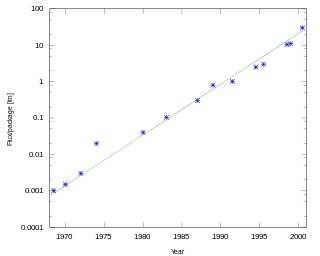Haitz's law

Haitz's law is an observation and forecast about the steady improvement, over many years, of light-emitting diodes (LEDs).
It states that every decade, the cost per lumen (unit of useful light emitted) falls by a factor of 10, and the amount of light generated per LED package increases by a factor of 20, for a given wavelength (color) of light. It is considered the LED counterpart to Moore's law, which states that the number of transistors in a given integrated circuit doubles every 18 to 24 months.[1] Both laws rely on the process optimization of the production of semiconductor devices.
Haitz's law is named after Roland Haitz (1935-2015),[2] a scientist at Agilent Technologies among others. It was first presented to the larger public at Strategies in Light 2000, the first of a series of annual conferences organized by Strategies Unlimited.[3] Besides the forecast of exponential development of cost per lumen and amount of light per package, the publication also forecast that the efficacy of LED-based lighting could reach 200 lm/W (lumen per Watt) in 2020, crossing 100 lm/W in 2010. This would be the case if enough industrial and government resources were spent for research on LED-lighting. More than 50% of the electricity consumption for lighting (20% of the totally consumed electrical energy) would be saved reaching 200 lm/W. This prospect and other stepping-stone applications of LEDs (e.g. mobile phone flash and LCD-backlighting) led to a massive investment in LED-research so that the LED efficacy did indeed cross 100 lm/W in 2010. If this trend continues, LEDs will become the most efficient light source by 2020.
In 2010, Cree Inc., developed and marketed the XM-L LED that claimed 1000 lumens at 100 lm/W efficacy and 160 lm/W at 350 mA and 150 lm/W at 700 mA.[4] They also claimed to have broken the 200 lm/W barrier in R&D with a prototype producing 208 lm at 350 mA.[5] In May 2011, Cree announced another prototype with 231 lm/W efficacy at 350 mA.[6] In March 2014, Cree announced another prototype with a record breaking 303 lm/W efficacy at 350 mA.[7]
The theoretical maximum for a white LED with phosphorescence mixing is 250 lm/W.[8]
Also see luminous efficiency for an overview of efficacies of various sources.
References
- ↑ "Haitz's law". doi:10.1038/nphoton.2006.78. Retrieved 2009-03-04.
- ↑ Wright, Maury. "In Tribute: Recognizing the life and work of LED pioneer Roland Haitz". ledsmagazine.com. Retrieved 19 August 2015.
- ↑ "Solid-state lighting: 'The case' 10 years after and future prospects". doi:10.1002/pssa.201026349.
- ↑ "Cree's New Lighting-Class LEDs Shatter Industry Performance Standards". 10 November 2010. Archived from the original on September 27, 2011. Retrieved 27 July 2011.
- ↑ "Cree Breaks 200 Lumen per Watt Efficacy Barrier". 3 February 2010. Archived from the original on July 20, 2011. Retrieved 27 July 2011.
- ↑ "Cree 231 Lumen per Watt LED Shatters LED Efficacy Records". 9 May 2011. Archived from the original on July 16, 2011. Retrieved 27 July 2011.
- ↑ "Cree First to Break 300 Lumens-per-Watt Barrier". 26 March 2014. Retrieved 7 May 2014.
- ↑ "Maximum Efficiency of White Light" (PDF). Retrieved 2011-07-31.
External links
- Roland Haitz, Fred Kish, Jeff Tsao, and Jeff Nelson; The Case for a National Research Program on Semiconductor Lighting, page 5; date of access: 4 February 2008.